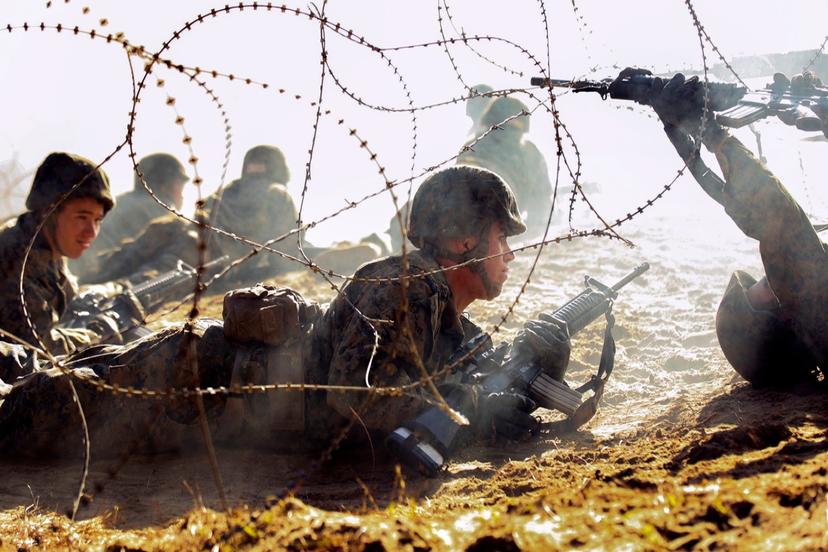Military Services

Background
America's earliest organized defense forces were the militias of the colonial states, which began to come together in the first decades of the 17th century. More than 100 years later, in 1775, the Continental Army was established to fight the British in the Revolutionary War. The colonists so valued the Army that its commander and most revered general, George Washington, became the first president of the United States.
The oldest continuous seagoing service in the United States, the Coast Guard, was established in 1790 to combat smuggling. In contrast, the first American marine units were attached to the Army at the time of its creation; these units then were made an independent part of the Navy when it was officially established in 1798. The Marine Corps was considered part of the Navy until 1834, when it established itself as both a land and sea defense force, thereby becoming its own military branch.
The air service grew from somewhat unusual beginnings. The Civil War marked the first use of aircraft in the U.S. military, when a balloon corps was attached to the Army of the Potomac. In 1892, a formal Balloon Corps was created as part of the Army's Signal Corps. By 1907, a separate Aeronautical Division was created within the Army. Air power proved invaluable a few years later during World War I, bringing about major changes in military strategy. As a result, the United States began to assert itself as an international military power, and accordingly, the Army Air Service was created as an independent unit in 1918, although it remained under Army direction for a time.
With the surprise attack on Pearl Harbor in 1941, America was plunged into World War II; at its height, 13 million Americans fought in the different branches of the military services. When the war ended, the United States emerged as the strongest military power in the Western world. A large part of America's military success was due to the superiority of its air forces. Recognition of the strategic importance of air power led to the creation of the now wholly independent branch of service, the U.S. Air Force, in 1947. Two years later, the various branches of military service were unified under the Department of Defense. (Note: Today, the U.S. Coast Guard falls under the administration of the U.S. Department of Homeland Security.)
In the years following World War II, the United States and its allies devoted their considerable military resources to fighting the cold war with the Soviet Union. Anticommunist tensions led to U.S. involvement in the Korean War during the 1950s and to participation in the Vietnam War, which ended in the mid-1970s. Antiwar sentiment grew increasingly insistent, and soon, the policies that established an American presence in foreign countries came under new demands for reevaluation. In 1973, the draft was abolished, and the U.S. military became an all-volunteer force. The armed forces began to put great energy into improving the image of military personnel and presenting the military as an appealing career option in order to attract talented recruits.
During the 1980s, the U.S. military increased its efforts to bring about the collapse of Soviet communism and became active in the Middle East, particularly in the Persian Gulf, through which supplies of much of the world's oil travel. Later in the decade, many countries under Soviet rule began to press for independence, and, in 1991, the Soviet Union finally collapsed under the weight of its political and economic crisis, effectively ending the cold war. That same year, the United States engaged in the Persian Gulf War.
In the late 1990s, a new role developed for the U.S. military as a peacekeeping force. For example, American troops were stationed in the Balkans to discourage renewed aggression in a longstanding civil war. Other active forces continued to monitor the Persian Gulf.
Reaction to the terrorist attacks of September 11, 2001, made the destruction of the strongholds and training camps of terrorists in Afghanistan and other countries around the world a top priority. Immediately after the attacks, recruitment offices reported a large increase in the number of calls from people who wanted to enlist. President Bush said the war against terrorism would likely be a sustained effort over a long period of time. U.S. troops, warships, and dozens of fighter planes were deployed to the Middle East and air and ground strikes on terrorist targets in Afghanistan began. In addition to military action, the administration used diplomatic, law enforcement, and financial strategies against those believed responsible for the attacks. Military efforts in Afghanistan remained ongoing as of 2020.
In March 2003, the United States, Great Britain, and a coalition of several other nations engaged in Operation Iraqi Freedom, which was part of the new war on terrorism. This campaign aimed to liberate the nation of Iraq from the dictatorship of Saddam Hussein, who was suspected of harboring weapons of mass destruction that might be used in future terrorist attacks. Although Hussein was captured and imprisoned in December 2003 and a permanent Iraqi government was established in 2006, the struggle to bring peace to the nation was waged by the men and women in the military of the United States until President Obama withdrew the last troops from Iraq in late 2011. However in 2014 hundreds of troops were deployed to protect American assets in Iraq and to advise Iraqi and Kurdish fighters.
